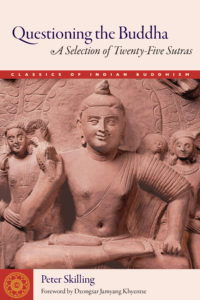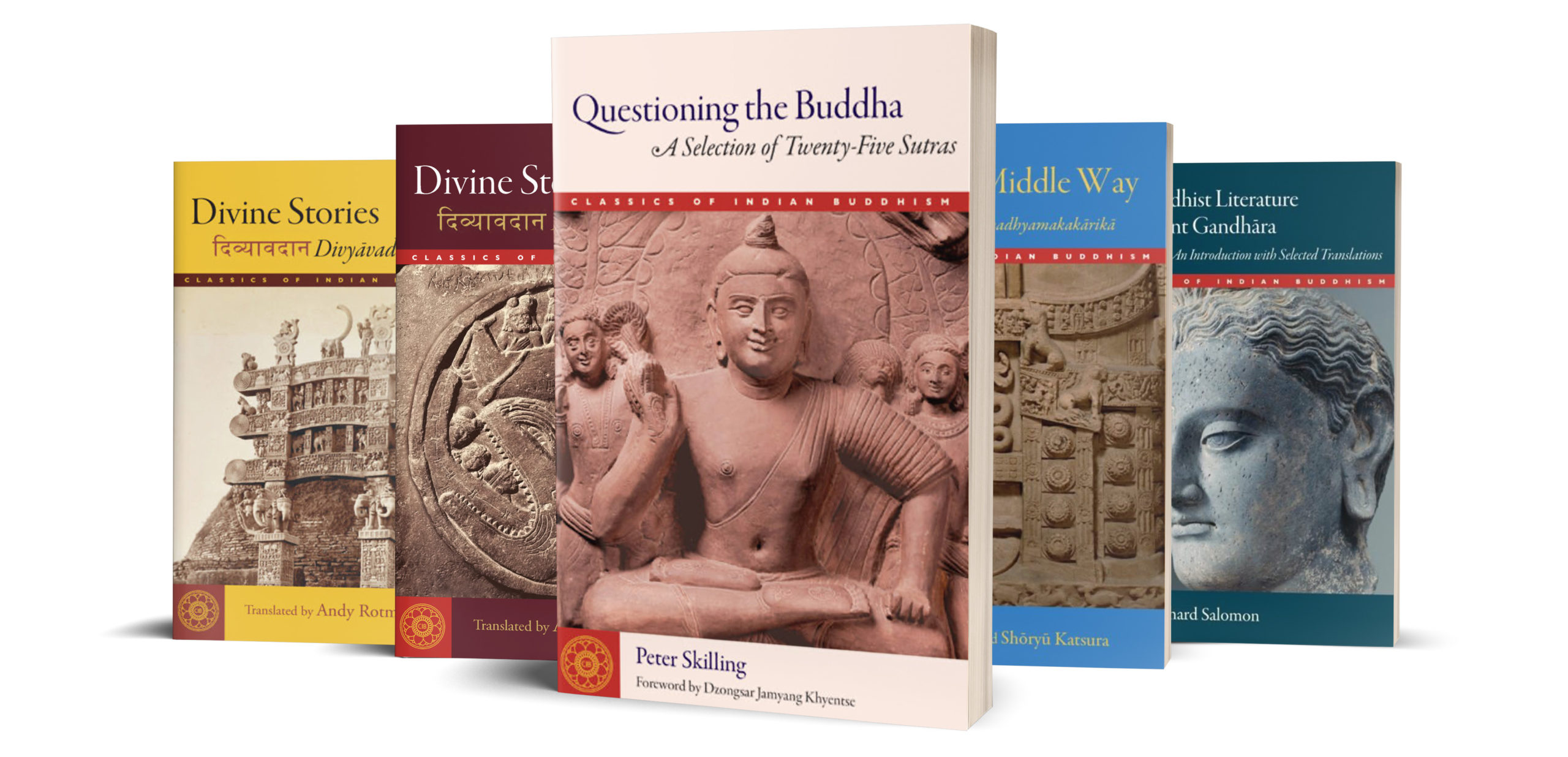The following is from Dzongsar Khyentse Rinpoche’s foreword to Questioning the Buddha by Peter Skilling.
About twenty years ago, my friend Albert told me about a Western scholar living in Thailand who was collecting Pali Buddhist texts. With my usual scepticism of Western academics, I thought this would be one of the many who shrug off the spiritual and traditional dimensions of Buddhism in the interests of intellect and science. But I had nothing to do that day, so I gave in to Albert’s plea to visit this man.
As soon as I met him, I was utterly humbled, moved, and inspired by Peter Skilling’s palpable love and dedication to saving precious Pali texts that might otherwise be lost forever. Here was a Westerner with no prior connection or cultural affinity with Buddhism, at least in this lifetime, who was doing far more to protect the Dharma than us lamas sitting on thrones and surrounded by our entourages.
From that time on, I have watched Peter Skilling’s work closely and, with the utmost admiration, have been delighted to converse with him about his extraordinary work, and I have benefited greatly from his sage advice over more than a decade. In 2012, Peter was appointed a Khyentse Foundation fellow in recognition of his outstanding contributions to Buddhist scholarship. It is rare individuals like the late Gene Smith and Peter Skilling who give me hope for the survival of the genuine Buddhadharma.
And so, I am deeply honored to contribute a short foreword to this splendid collection of twenty-five translations of complete sūtra texts from the Kangyur. Without the Kangyur—the actual words of the Buddha—there is no foundation to the Buddhadharma, and without translation into modern languages, this remarkable treasury of spiritual literature and guidance will be lost. The sūtras started out in Prakrit and then Sanskrit in ancient India; traveled to Tibet where they were translated into Tibetan under the sponsorship of great Dharma kings; and now at last are being translated into English in order to preserve the Buddha’s teaching and make the Dharma widely available.
"I was utterly humbled, moved, and inspired by Peter Skilling’s palpable love and dedication to saving precious Pali texts."
The texts translated in this volume belong to different genres, different formats, and different styles. Some are questions, some are expositions, and some are sūtras. The questioners include women and men, kings and monks, gods and bodhisattvas. They encounter the Buddha in all his confidence, radiance, and glory, which naturally leads to conversations and questions. This gives the contents of this book a wonderfully human context. We can imagine the laywoman Gangottara (translation 18) going home and telling her family, “I went to see the Buddha today, and we talked about emptiness and what not. I didn’t quite agree with everything he said, but what a great talk we had!”
In this volume, prose and verse join beautifully to celebrate the Dharma. The selections show how rich, how diverse, and how wonderful the Kangyur is—and how little we know about it. How can we pretend to know the scriptures and to know our Buddhist heritage when so little has been translated into modern languages?
And so, I am really pleased to welcome these translations by Peter Skilling. In this age of globalization, I’d like to think that one of the greatest benefits of the growing connectedness of life around the world is translation of ancient texts into modern languages. Only in this way can the living Dharma be translated into the daily lives of people around the world. Only thus can they learn to live and breathe the Dharma.
The Buddha advised us to transmit the Dharma in our own languages, and to tell the truth like it is without attachment to particular forms. To me, living in this day and age, that means we should make these priceless treasures of Buddhist thought accessible today in reliable English versions. Whether we like it or not, English is now the primary vehicle of thought and ideas around the world. For better or for worse, we Buddhists need to accept this reality and use this language to benefit humanity and all living beings. It’s not that English versions are any better than those in Thai, French, Russian, Japanese, or Esperanto, but they will initially preserve and spread the Dharma more widely that way. As a second step, of course, the translations should also be made available in other languages. Whatever the language, of course, the real thing is the gem, not the particular case or package that holds it.
"In this volume, prose and verse join beautifully to celebrate the Dharma. The selections show how rich, how diverse, and how wonderful the Kangyur is—and how little we know about it."
These days we prattle a lot about pride in cultural heritage, but a lot of that is pious nonsense to justify our habitual patterns and attachment to our particular comfort zones. That can lead and has led to serious misconceptions, misinterpretations, and misunderstandings that distort and contort the genuine Buddhist teachings. As the Buddha tells a mighty Brahmā god in Brahmā Sahāṃpati’s Question (translation 19), the true Buddhadharma is the direct path that leads us straight to pristine awareness of our bodies, speech, thoughts, and mind. Anything that lacks this immaculate wisdom and compassion is counterfeit Dharma.
Here are twenty-five texts, many of them never previously translated. But that doesn’t mean twenty-five different flavors, because each text is itself packed with many flavors and a wealth of powerful ideas and guidance. But no matter how many flavors, moods, styles, and contexts we might savor in each of these texts, they are also all pervaded by one single flavor that delivers the taste of complete freedom and liberation.
There’s another key message in these texts—that what you get out of anything depends on what you put into it—like the dear lady who used up all her meager resources on just a thimbleful of oil to light a lamp to celebrate the Buddha (translation 15). It didn’t matter how much money she had—whatever we can afford is enough—she will become a buddha. And there are other powerful messages throughout this volume.
The Dharma used to be written down on palm leaves and measured in bundles. That’s why Peter Skilling founded the Fragile Palm Leaves Foundation, a wonderful nonsectarian organization that preserves a large collection of palm-leaf manuscripts in Pali and supports the study of the Buddhist literature of Southeast Asia. Since Khyentse Foundation’s establishment nearly eighteen years ago, we have been proud to lend some modest support to this invaluable work.
In this volume we have just twenty-five precious bundles out of the 84,000 bundles of the Buddhadharma. I hope each one of these will be appreciated, savored, and enjoyed by readers around the world. May these pearls of wisdom lead readers to complete liberation.
"There’s another key message in these texts—that what you get out of anything depends on what you put into it."
 In the forty-five years the Buddha spent traversing northern India, he shared his wisdom with everyone from beggar women to kings. Hundreds of his discourses, or sutras, were preserved by his followers, first orally and later in written form. Around thirteen hundred years after the Buddha’s enlightenment, the sutras were translated into the Tibetan language, where they have been preserved ever since. To date, only a fraction of these have been made available in English. Questioning the Buddha brings the reader directly into the literary treasure of the Tibetan canon with thoroughly annotated translations of twenty-five different sutras. Often these texts, many translated here in full for the first time, begin with an encounter in which someone poses a question to the Buddha.
In the forty-five years the Buddha spent traversing northern India, he shared his wisdom with everyone from beggar women to kings. Hundreds of his discourses, or sutras, were preserved by his followers, first orally and later in written form. Around thirteen hundred years after the Buddha’s enlightenment, the sutras were translated into the Tibetan language, where they have been preserved ever since. To date, only a fraction of these have been made available in English. Questioning the Buddha brings the reader directly into the literary treasure of the Tibetan canon with thoroughly annotated translations of twenty-five different sutras. Often these texts, many translated here in full for the first time, begin with an encounter in which someone poses a question to the Buddha.
Peter Skilling, an authority on early Buddhist epigraphy, archaeology, and textual traditions, has been immersed in the Buddhist scriptures of diverse traditions for nearly half a century. In this volume, he draws on his deep and extensive research to render these ancient teachings in a fresh and precise language. His introduction is a fascinating history of the Buddhist sutras, including the transition from oral to written form, the rise of Mahayana literature, the transmission to Tibet, the development of canons, and a look at some of the pioneers of sutra study in the West.
Classics of Indian Buddhism
The flourishing of Buddhism in South Asia during the first millennium of the Common Era produced many texts that deserve a place among the classics of world literature. Exploring the full extent of the human condition and the limits of language and reason, these texts have the power to edify and entertain a wide variety of readers. The Classics of Indian Buddhism series aims to publish widely accessible translations of important texts from the Buddhist traditions of South Asia, with
special consideration given to works foundational for the Mahāyāna.
| There are no products in your cart. |


